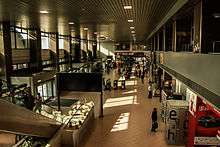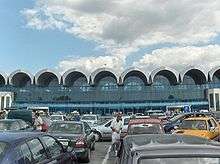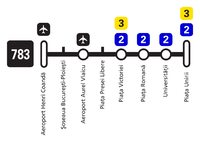Henri Coandă International Airport
| Bucharest Henri Coandǎ International Airport Aeroportul Internațional Henri Coandă București | |||||||||||||||
|---|---|---|---|---|---|---|---|---|---|---|---|---|---|---|---|
 | |||||||||||||||
 | |||||||||||||||
| Summary | |||||||||||||||
| Airport type | Public / Military | ||||||||||||||
| Operator | The National Company "Bucharest Airports" S.A. | ||||||||||||||
| Serves | Bucharest, Romania | ||||||||||||||
| Location | Otopeni | ||||||||||||||
| Hub for | TAROM | ||||||||||||||
| Focus city for | |||||||||||||||
| Elevation AMSL | 314 ft / 96 m | ||||||||||||||
| Coordinates | 44°34′16″N 026°05′06″E / 44.57111°N 26.08500°ECoordinates: 44°34′16″N 026°05′06″E / 44.57111°N 26.08500°E | ||||||||||||||
| Website | bucharestairports.ro | ||||||||||||||
| Map | |||||||||||||||
 OTP Location within Romania | |||||||||||||||
| Runways | |||||||||||||||
| |||||||||||||||
| Helipads | |||||||||||||||
| |||||||||||||||
| Statistics (2016) | |||||||||||||||
| |||||||||||||||
Bucharest Henri Coandă International Airport (Romanian: Aeroportul Internațional Henri Coandă București) (IATA: OTP, ICAO: LROP) is Romania's busiest international airport, located in Otopeni, 16.5 km (10.3 mi) north of Bucharest's city centre.[1] It is currently one of two airports serving the capital of Romania. The other is Aurel Vlaicu Airport, which no longer serves scheduled passenger traffic.
The airport is named after Romanian flight pioneer Henri Coandă, builder of Coandă-1910 aircraft and discoverer of the Coandă effect of fluidics. Until May 2004, the official name was Bucharest Otopeni International Airport (Romanian: Aeroportul Internațional București Otopeni), which remains the name by which it is generally known.
Henri Coandă International Airport serves as headquarters for TAROM, the country's national airline.[3] It also serves as a base of operations for low-cost airlines Blue Air, Ryanair and Wizz Air. It is managed by The National Company Bucharest Airports S.A. (Compania Națională Aeroporturi București S.A.).[4] The military section of the airport is used by the 90th Airlift Flotilla of the Romanian Air Force.
History
Early years

During World War II, the airport in Otopeni was used as an airbase by the German air force. Up to 1965, it was restricted for military use and was one of the major bases of the Romanian Air Force, with a runway of 1,200 metres (3,900 ft). Băneasa Airport was the only airport that Bucharest used for commercial flights. In 1965, with the growth of air traffic, a new commercial airport was constructed in the settlement of Otopeni, where the military air base used to be. The runway was modernised and extended up to 3,500 metres (11,500 ft), making it one of the longest in Europe at that time.[5]
In August 1969, when United States President Nixon visited Romania, a VIP lounge was inaugurated. A new passenger terminal (designed by Cezar Lăzărescu), with a capacity of 1,200,000 passengers per year, was opened on 13 April 1970, for domestic and international flights.[5] The airport slowly became more and more used by airlines, with a growing number of passengers. In 1986, it entered a new phase of development. A second 3500-metre runway was constructed, as well as related taxiways. The airport lighting system was improved and the capacity was increased to 35 airport movements per hour.[5]
In 1992, Otopeni Airport became a regular member of Airports Council International (ACI).
Expansion since the 1990s
The first stage of the plan (Phase I), taking place between 1994 and 1998, involved the construction a new departures terminal and of a new airside concourse with five jetways and nine gates (referred to as 'the Finger') as well as the extension of airport ramps and of their associated taxiways.[6]
The second phase (labeled Phase II/IIe) of the plan led to the construction of a terminal dedicated to domestic flights and of a multi-story car park (2003), the complete overhaul of the control tower (between 2005–2007) as well as the transformation of the old terminal building in a dedicated arrivals hall (in 2000). During the same phase, two high-speed taxiways (Victor and Whiskey) were constructed. Phase II was completed in 2007.[6]
The third stage of the plan (Phase III), which started in 2009, involved the extension of the airside concourse ('the Finger') with 15 new gates (nine of which have jetways), as well as the expansion of the Departure Hall (with 8 new gates). The airside concourse extension, designed by Studio Capelli Architettura & Associati, and measuring 17,000 square metres (200,000 sq ft), was inaugurated on 29 March 2011.[6][7] It was followed, in November 2012, by the extension of the Departure Hall to a total area of 38,600 square metres (400,000 sq ft).[8][9]
In March 2012, all air traffic except for business air traffic was transferred from Aurel Vlaicu International Airport (at that time Bucharest's low-cost hub) to Henri Coandă International Airport.
Terminals
The airport's facilities consist of a single terminal with three main facilities (colloquially referred to as "Terminals"): the Departures Hall/Terminal, the Arrivals Hall/Terminal, and the Finger Terminal (the airside concourse).[10] A walkway with shops connects the departures and arrivals buildings. The airside concourse is organized in two (domestic and international) passengers flows.[11] The entire terminal has 38 gates (of which 14 equipped with jetways),[8] and a total floor area of 86,000 square metres (930,000 sq ft).[5][7][9]
Future development
Beyond Phase III, a new terminal building (Henri Coandă 2) at the eastern end of the current location is envisaged. Henri Coandă 2 will be of a modular design, consisting of four separate buildings, each capable of handling 5 million passengers annually. Each module will be built as traffic demands dictate. Thus, by 2023, Terminal 2 alone should be able to handle the 20 million passengers per year indicated by estimates. The terminal will be directly connected to A3 motorway, to the railway system, and to the Bucharest Metro system through Metro Line 6.[12]
Airlines and destinations
Passenger
Cargo
| Airlines | Destinations |
|---|---|
| ASL Airlines Belgium | Liège, Munich, Sofia |
| DHL Aviation | Bergamo, Budapest, Chișinău, Treviso |
| UPS Airlines operated by ASL Airlines Switzerland | Cologne/Bonn, Katowice |
Statistics
Passengers



In 2016, 10,981,652 passengers passed through the airport, an increase of 18.3% compared to 2015.[19]
| Year | Passengers (total)[19] | Change[19] | Passengers (domestic flights) | Aircraft movements[20] | Cargo |
|---|---|---|---|---|---|
| 2005 | 2,972,799 | 49,593 | 16,887 tonnes | ||
| 2006 | 3,497,938 | 55,056 | 18,089 tonnes | ||
| 2007 | 4,937,683 | 410,916 | 67,372 | 17,423 tonnes | |
| 2008 | 5,063,555 | 497,208 | 69,916 | ||
| 2009 | 4,480,765 | 496,391 | 69,692 | ||
| 2010 | 4,916,964 | 71,481 | |||
| 2011 | 5,049,443 | ||||
| 2012 | 7,120,024 | 98,600 | |||
| 2013 | 7,643,467 | 106,159 | |||
| 2014 | 8,316,705 | 91,788 | |||
| 2015 | 9,282,884 | 97,218 | |||
| 2016 | 10,982,967 | 108,200 |
 |
| Month | Passengers[19] | Change (2016–2017) | Passengers Cumulatively |
|---|---|---|---|
| January | 847,222 | 847,222 | |
| February | 809,445 | 1,656,667 | |
| March | 942,360 | 2,599,027 | |
| April | 1,045,181 | 3,644,208 | |
| May | 1,102,438 | 4,746,646 |
Busiest routes
| Rank | Airport | Passengers 2016 (01.01-30.09) | Carriers | |||||
|---|---|---|---|---|---|---|---|---|
| 1 | | Blue Air, TAROM | ||||||
| 2 | | Blue Air, TAROM, Wizz Air | ||||||
| 3 | | Ryanair, TAROM | ||||||
| Sources:Eurostat,[21] INSSE[22] | ||||||||
Ground transportation
Rail
A direct train service to the main railway station, Gara de Nord, runs from the Airport railway station, about 900 m from the airport. Shuttle buses connect this station with the departures and arrivals halls; the tickets are valid for the train and for the transfer bus.[23] The next phase of the expansion aims to locate the train station in the airport itself.
A project which includes the construction of the M6 metro line, connecting the airport to Gara de Nord train station and the rest of the metro and public transport network, was also proposed.

Bus
Henri Coandă Airport is connected to the public transport company RATB system. The 780 route provides express bus service to Gara de Nord and Gara Basarab railway stations in Bucharest, and the 783 route provides express bus service to the city center (Piața Unirii).[24]
Car
The airport is 16.5 km (10.3 mi) north of central Bucharest, to which it is connected by route DN1. The A3 motorway will connect the airport and the city, when finished.
Taxi
As of May 2013, taxis serving Henri Coandă Airport can be ordered using a touch screen system in the arrivals terminal, allowing the taxi drivers to enter the pick-up area. This measure was taken after many complaints from passengers who were being ripped off when using illegal, high-price taxis.[25] At the end of 2016, controversy started after taxi drivers complained about transportation network companies operating in Bucharest, such as Uber and Taxify, advertising their services on airport premises. [26]
See also
- Aviation in Romania
- Transportation in Romania
- List of the busiest airports in Europe by passenger traffic
References
- 1 2 "EAD Basic – Error Page". Retrieved 3 June 2015.
- ↑ Bucharest Airports: record air traffic in 2015
- ↑ "TAROM S.A. – Identification Data
- ↑ "Contact." Henri Coandă International Airport. Retrieved on 1 December 2011. "The National Company "Bucharest Airports" S.A. Calea Bucurestilor nr. 224 E Otopeni, Ilfov County Postal code 075150 Romania" – Address in Romanian: "Compania Națională "Aeroporturi București" S.A. Calea Bucureștilor nr. 224 E Otopeni, județul Ilfov Cod postal 075150 România"
- 1 2 3 4 AIHCB 2007 Report at bucharestairports.ro
- 1 2 3 (in Romanian) Romanian Ministry of Transportation – Descriptive Note – Otopeni Airport Development Strategy
- 1 2 "Bucharest Airport at a10.eu
- 1 2 New Departure Hall extension opened (in Romanian)
- 1 2 Noul Terminal Plecari al Aeroportului Otopeni (in Romanian)
- ↑ Bucharest Otopeni Airport, the last frontier (in Romanian)
- ↑ A new terminal (in Romanian)
- ↑ (in Romanian) The Romanian Ministry of Transportation
- ↑ Arkia. "Arkia Israeli Airlines - Flights to Tel Aviv, Eilat Packages, Hotels in Israel". www.arkia.com. Retrieved 25 May 2017.
- ↑ "Blue Air plans additional routes in S17". Routesonline. Retrieved 13 March 2017.
- ↑ "Croatia Airlines schedules new routes in S17". Routesonline. Retrieved 6 March 2017.
- ↑ "Tour operator Mouzenidis Travel". Retrieved 25 May 2017.
- 1 2 http://www.newsair.ro/wizz-air-adauga-zboruri-spre-goteborg-si-nisa-din-aprilie-2018.html Wizz Air begins flights to Nice and Goreborg in April 2018
- ↑ http://www.routesonline.com/news/38/airlineroute/274229/wizzair-expands-eilatovda-network-in-w17/
- 1 2 3 4 "Anna.aero database". Retrieved 25 May 2017.
- ↑ ORDIN 169/1.801. Planul național de acțiune privind reducerea emisiilor de gaze cu efect de seră în domeniul aviației civile (in Romanian)
- ↑ http://ec.europa.eu/eurostat
- ↑ "Transportul aeroportuar pe anul 2015" (PDF). INSSE. (in Romanian)
- ↑ "Bucharest Airports – Bucharest Henri Coandă International Airport – Train connection". Retrieved 3 June 2015.
- ↑ "Bucharest Airports – Bucharest Henri Coandă International Airport – Bus". Retrieved 3 June 2015.
- ↑ "Touch screen installed for cab ordering at Otopeni airport in Bucharest". Romania Insider. Retrieved 2 May 2013.
- ↑ "Taxi companies want Uber ad removed from Bucharest airport", Romania Insider, retrieved 29 Nov 2016
External links
![]() Media related to Henri Coandă International Airport at Wikimedia Commons
Media related to Henri Coandă International Airport at Wikimedia Commons